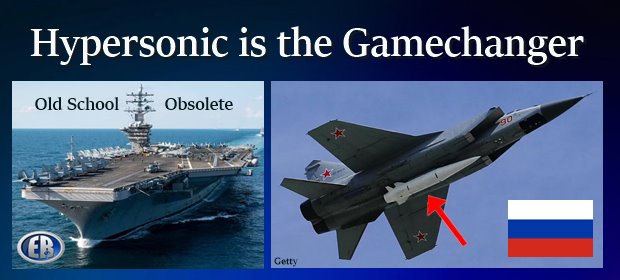
Why hypersonic weapons change everything? They can sink all American aircraft carriers at once
When it comes to all things military, I follow a handful of analysts, including Croatian Admiral Davorin Domazet (retired), who is perhaps my favourite. He has a deep and detailed command of technical matters (like Andreiy Martyanov, he emphasizes that you cannot prevail in modern warfare without a deep knowledge of advanced mathematics and probability). More importantly, he has perhaps the clearest insight into the broad historical context of the current conflict between Russia and the Western powers, writes Alex Krainer.
Unfortunately, Admiral Domazet doesn’t give many interviews and none in English, but I thought his last interview was important enough to share more widely in this article.

If you happen to speak Croatian/Serbian, you can find the interview, published on March 17, 2023, at this link. It takes more than 2 hours.
The context is everything
Domazet is the only military analyst I know who takes into account the history of the Western financial oligarchy, their Venetian roots, the migration to Amsterdam where they formed the Dutch Empire, and the subsequent move to London, which to this day remains today the ideological and spiritual headquarters of the undead British Empire.
He has rightly labeled the enemy of mankind as the “Western occult oligarchy”, and has even called the war in Ukraine the clash between Christ and the Antichrist, underlining that the Antichrist is in the West. Mind you, Croatia is a NATO member state and, like Poland, is a Catholic Slavic nation, even sharing some of its cultural Russophobia (although it may not be as rabid in Croatia as it is in Poland).
About Russia’s Hypersonic Weapons
But the part of Domazet’s last interview that I thought was particularly worth sharing was what he talked about Russia’s hypersonic weapons.
It was in 2018 that Vladimir Putin took the stage to present Russia’s new hypersonic weapons. The term “hyssonic” refers to rockets flying at speeds of 5 mach and above. At the time, many in the west dismissed Putin’s claims, thinking it was a bluff. We now know he wasn’t bluffing. Russia is the only country in the world that has deployable hypersonic missiles – not one, but three types: Zircons, Kinzhals and Avantguards.
Domazet explained why these weapons are revolutionizing warfare. In World War I, tanks were the game-changing military technology. It has been the Air Force since World War II. Aircraft carriers were an irresistible force wherever they traveled and have dominated the seas ever since. But hypersonic precision missiles made that power obsolete overnight.
The most important military front in the current global conflict, according to Domazet, are the anti-ballistic (ABM) batteries that the US has deployed on the Poland-Romania axis and the Russians on the North Pole-Kaliningrad-Crimea-Syria axis. These are defensive systems, intended to intercept incoming nuclear missiles (although they can be easily converted to offensive nuclear missiles). However, current ABM systems are only effective against missiles with a speed up to Mach 3.5 (3.5 times the speed of sound).
The Kinzhal turns mighty carrier strike groups into targets
Russia’s new Kinzhal missile flies at speeds from Mach 12 to Mach 15 and nothing in Western defense arsenals can stop its onslaught. During the war in Ukraine, Russia gave a stunning demonstration of its power. The first Kinzhal attack, a month after the start of hostilities in Ukraine, was perhaps the most significant: Russian forces targeted a large arms depot in Ukraine, built during the Soviet era to withstand a nuclear attack. It was 170 meters underground and protected by several layers of reinforced concrete.
The Kinzhal flies at an altitude of 20 to 40 km, with a maximum range of 2,000 km. Above the target, it plummets down and accelerates to 15 mach, generating enormous kinetic energy in addition to its explosive charge. That first strike with a single Kinzhal missile destroyed Ukraine’s nuke-proof underground weapons depot. This was a message for the West.
Moscow signals: we can sink ALL your aircraft carriers
The Kinzhal was developed for the express purpose of destroying carrier strike groups. If it can destroy a repository that can withstand a nuclear attack, it can cut through an aircraft carrier like a hot knife through butter.

According to Admiral Domazet, neither the Western powers nor China have such weapons. He explained that the critical point in hypersonic weapons is the extreme temperatures reached on the surface of missiles during hypersonic flight, which can cause them to break up in flight. Russia is the only nation that has developed special materials that enable the missiles to withstand this stress, so that their flight can be controlled throughout the trajectory and delivered with pinpoint precision.
Western intelligence estimates that Russia had about 50 Kinzhals at the start of the war in Ukraine, and so far it has used only 9. Last week they fired six Kinzhals in a single salvo. That too was a message. Here’s how Domazet explained it: The United States has 11 carrier strike groups. Of these, less than half are active at any one time (while others are in dock for maintenance or are being prepared). Firing six Kinzhals at once is military parlance for “we have the ability to sink ALL of your carriers at once.”
Russia could run out of ammunition at any moment (Western experts say)…
Russia has the capacity to build about 200 Kinzhals a year and now has the means to deliver Kinzhal and Zircon missiles anywhere from aircraft, ships and submarines. In addition to destroying aircraft carriers, they can also destroy NATO’s ABM missile sites. In short, Russia is now a clear winner of the 21st century arms race.
It may take the Western powers 10 years or more to catch up and until then, the only way to avoid losing the war is to either admit defeat and accept Russia’s security demands or let the conflict escalate to a nuclear exchange.
At a conservative estimate, at least a billion people would die in such a conflict and no one would win. Who would do such a thing? In fact, the idea of using nuclear weapons is so repugnant that we can be sure that our leaders will never choose the path of escalation. No one is that evil, right? However…?
************
Source
Featured image, aircraft carrier: MC3 Kaleb Sarten/Navy
Featured image, Kinzhal missile, MiG-31: Getty

••••
The Liberty Beacon Project is now expanding at a near exponential rate, and for this we are grateful and excited! But we must also be practical. For 7 years we have not asked for any donations, and have built this project with our own funds as we grew. We are now experiencing ever increasing growing pains due to the large number of websites and projects we represent. So we have just installed donation buttons on our websites and ask that you consider this when you visit them. Nothing is too small. We thank you for all your support and your considerations … (TLB)
••••
Comment Policy: As a privately owned web site, we reserve the right to remove comments that contain spam, advertising, vulgarity, threats of violence, racism, or personal/abusive attacks on other users. This also applies to trolling, the use of more than one alias, or just intentional mischief. Enforcement of this policy is at the discretion of this websites administrators. Repeat offenders may be blocked or permanently banned without prior warning.
••••
Disclaimer: TLB websites contain copyrighted material the use of which has not always been specifically authorized by the copyright owner. We are making such material available to our readers under the provisions of “fair use” in an effort to advance a better understanding of political, health, economic and social issues. The material on this site is distributed without profit to those who have expressed a prior interest in receiving it for research and educational purposes. If you wish to use copyrighted material for purposes other than “fair use” you must request permission from the copyright owner.
••••
Disclaimer: The information and opinions shared are for informational purposes only including, but not limited to, text, graphics, images and other material are not intended as medical advice or instruction. Nothing mentioned is intended to be a substitute for professional medical advice, diagnosis or treatment.





Indeed. Analysts say basically that China needs Russia to win in Ukraine because if Russia loses (obviously impossible), China will be the next target of the western deep state. It’s good to know that Russia is powerful and independent.
A weapon destroyer : great news !
“neither the Western powers nor China have such weapons” : Very important also to know that China cannot own Russia.